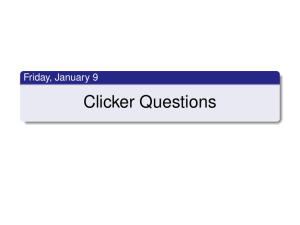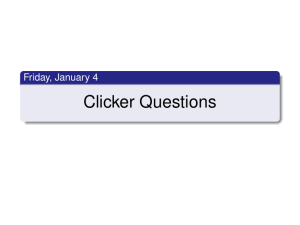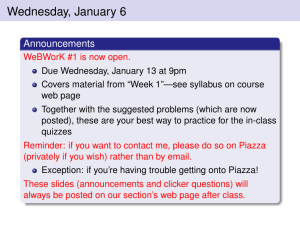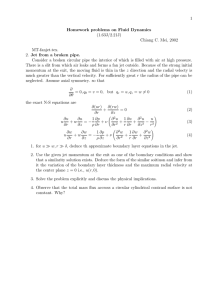ICAO Standard Phraseology A Quick Reference Guide
advertisement
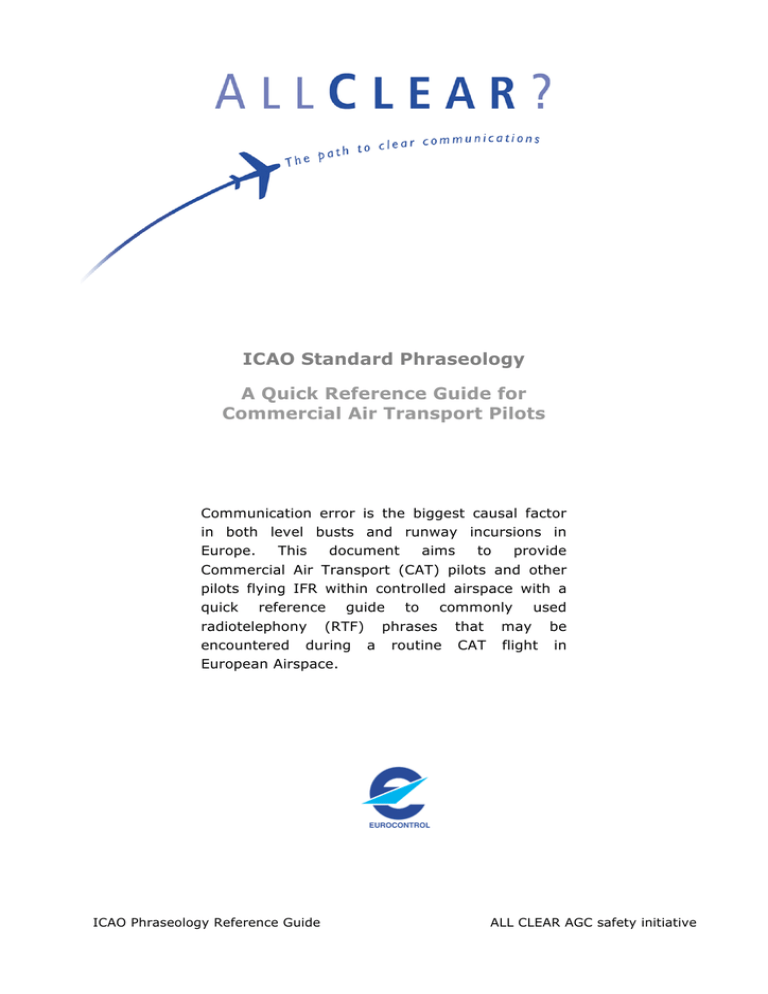
ICAO Standard Phraseology A Quick Reference Guide for Commercial Air Transport Pilots Communication error is the biggest causal factor in both level busts and runway incursions in Europe. This document aims to provide Commercial Air Transport (CAT) pilots and other pilots flying IFR within controlled airspace with a quick reference guide to commonly used radiotelephony (RTF) phrases that may be encountered during a routine CAT flight in European Airspace. ICAO Phraseology Reference Guide ALL CLEAR AGC safety initiative Introduction Communication error is the biggest causal factor in both level busts and runway incursions in Europe. This document aims to provide Commercial Air Transport (CAT) pilots and other pilots flying IFR within controlled airspace with a quick reference guide to commonly used radiotelephony (RTF) phrases that may be encountered during a routine CAT flight in European Airspace. It also explains some of the rationale behind the use of certain words and phrases to aid understanding and reinforce the need for compliance with standard phraseology. The goal is to improve safety by raising RTF standards. The need for clear and unambiguous communication between pilots and Air Traffic Control (ATC) is vital in assisting the safe and expeditious operation of aircraft. It is important, therefore, that due regard is given to the use of standard words and phrases and that all involved ensure that they maintain the highest professional standards when using RTF. This is especially important when operating within busy sectors with congested frequencies where any time wasted with verbosity and non-standard, ambiguous phrases could lead to flight safety incidents. Phraseology has evolved over time and has been carefully developed to provide maximum clarity and brevity in communications while ensuring that phrases are unambiguous. However, while standard phraseology is available to cover most routine situations, not every conceivable scenario will be catered for and RTF users should be prepared to use plain language when necessary following the principle of keeping phrases clear and concise. ICAO Phraseology Reference Guide 2 ALL CLEAR AGC safety initiative Contents 1. Clearance and Taxi 2. Take-off and Departure 3. Read-back 4. Climb, Cruise and Descent 5. Approach and Landing 6. Emergency Communications Note: This document uses RTF examples showing both pilot (denoted by blue italic text) and ATCO (denoted by grey text) communication. For example: Pilot - Metro Ground, Big Jet 345, request taxi ATC - Big Jet 345, Metro Ground, taxi to holding point A1, hold short of Runway 18 ICAO Phraseology Reference Guide 3 ALL CLEAR AGC safety initiative CLEARANCE AND TAXI ICAO Phraseology Reference Guide 4 ALL CLEAR AGC safety initiative Taxiing - A Safety Critical Activity RTF is crucial to the safety of the flight during taxiing. Any mistake that causes the aircraft to enter a runway in error could be catastrophic. Taxi Clearance Limit All taxi clearances will contain a clearance limit, which is the point at which the aircraft must stop unless further permission to proceed is given. Noting Down Taxi Clearances Complex or lengthy taxi clearances should be noted down by crews. RTF Taxi Instructions to Departure Runway Metro Ground, Big Jet 345, request taxi Big Jet 345, Metro Ground, taxi to holding point C, runway 27 Taxi to holding point C, runway 27, Big Jet 345 Big Jet 345, contact Metro Tower 119.2 Contact Metro Tower 119.2, Big Jet 345 Crossing an Intermediate Runway If a taxi route involves crossing a runway, whether active or not, specific clearance to cross that runway is required. Departure Delay Information Departure sequence information such as ‘number 5 to depart’ or ‘expect departure in …’ is NOT a take-off clearance. RTF Taxiing Across an Intermediate Runway Metro Ground, Big Jet 345, request taxi Big Jet 345, Metro Ground, taxi to holding point A1 runway 18 Taxi to holding point A1 runway 18, Big Jet 345 When traffic permits Big Jet 345 cross runway 18 at A1, taxi to holding point C, runway 27 Cross runway 18 at A1, taxi to holding point C, runway 27, Big Jet 345 ICAO Phraseology Reference Guide 5 ALL CLEAR AGC safety initiative NB: ATC may request Big Jet to confirm when Runway 18 is vacated A Conditional Taxi Clearance Conditional clearances may expedite traffic flow, but there are risks. Read-back must be in full and in the same sequence as given. A taxi clearance, shown below, allows taxi after another action has first taken place ie. the condition of the clearance. Where there may be ambiguity as to the subject of the condition, additional details such as livery and/or colour are given to aid identification. A conditional taxi clearance allows the aircraft to taxi only after another action has taken place. The structure and order of conditional clearances is essential to their safe execution. Correct read-back of a conditional clearance is vital. Metro Delivery, Big Jet 345, Stand Bravo 1, Boeing 737 with information Q, QNH1006, request clearance Big Jet 345, Metro Delivery, Cleared to Smallville, T1A departure, Squawk 3456, slot time 1905 Cleared to Smallville, T1A, Squawk 3456, Big Jet 345 Big Jet 345, request start up Big Jet 345, start up approved, contact Metro Ground 118.750 for taxi instructions Start up approved, contact Metro Ground 118.750 for taxi instructions, Big Jet 345 Metro Ground, Big Jet 345 Stand B1, request taxi Big Jet 345, Metro Ground, after the red and white Antonov with the purple fin, taxi to holding point runway 08 After the red and white Antonov with the purple fin, taxi to holding point runway 08, Big Jet 345 ICAO Phraseology Reference Guide 6 ALL CLEAR AGC safety initiative *ICAO: In all cases a conditional clearance shall be given in the following order and consist of: 1. Identification; 2. The condition 3. The clearance; and 4. Brief reiteration of the condition Conditional clearance to cross the intermediate runway: Conditional phrases, such as “behind landing aircraft” or “after departing aircraft”, shall not be used for movements affecting the active runway(s), except when the aircraft or vehicles concerned are seen by the appropriate controller and pilot. The aircraft or vehicle causing the condition in the clearance issued shall be the first aircraft/vehicle to pass in front of the other aircraft concerned. NB: Beware - the ICAO phrase ‘behind’ has been misinterpreted as an instruction to ‘get close to’ the preceding aircraft, leading to serious jet blast incidents. Big Jet 345, after landing Airbus 321, cross Runway 09 at C2, after After landing Airbus 321, cross Runway 09 at C2 after, Big Jet 345 Then: Big Jet 345, taxi to holding point C1, runway 27 Taxi to holding point C1, runway 27, Big Jet 345 Then: Big Jet 345, contact Metro Tower 123.625 Contact Metro Tower 123.625, Big Jet 345 ICAO Phraseology Reference Guide 7 ALL CLEAR AGC safety initiative TAKE OFF AND DEPARTURE ‘Take-off’ shall only be used when issuing a clearance to take-off. § Do not use phrases such as ‘prior to take-off’ or ‘after take-off’. § If the controller uses ‘after departure’ or ‘follow’, this is NOT a clearance to take-off. Any instructions to HOLD, HOLD POSITION or HOLD SHORT OF, shall be read back in full using the appropriate phrase – HOLDING or HOLD SHORT OF. In the airport environment, the word ‘cleared’ shall only be used in connection with a clearance to take-off or land. To aid clarity, a take-off clearance will always be issued separately. RTF Take-off Clearance Metro Tower, Big Jet 345, approaching holding point C1 Big Jet 345, Metro Tower, line up runway 27 Lining up runway 27, Big Jet 345 Big Jet 345, runway 27, cleared for take-off Cleared for take-off, Big Jet 345 Once airborne: Big Jet 345, contact Metro Radar 124.6 Contact Metro Radar on 124.6, Big Jet 345 Amendment to Departure Clearance Amendments to departure clearances are known to contribute to runway incursion incidents. The phraseology for amendments to departure clearances where the aircraft is approaching the runway will begin with ‘hold position’. ICAO Phraseology Reference Guide 8 ALL CLEAR AGC safety initiative RTF Amendment to Departure Clearance Metro Tower, Big Jet 345, approaching holding point C1 Big Jet 345, Metro Tower, hold at C1 Hold at C1, Big Jet 345 Big Jet 345, hold position, amendment to clearance, T3F departure, climb to 6000 feet Holding, T3F departure, climb to 6000 feet, Big Jet 345 Or: Big Jet 345 hold position, after departure climb to altitude 6000 feet Holding, after departure climb to 6000 feet, Big Jet 345 Conditional Line-Up Clearance Important points involving the active runway: § The condition is always given directly after the call-sign and before the clearance. § Conditional clearances must be read back in full and in exactly the same sequence as given plus a brief reiteration of the condition. § The aircraft or vehicle that is the subject of the condition must be visible to the flight crew and the controller. § The subject aircraft or vehicle of the condition shall be the next aircraft/vehicle to pass. § The condition must relate to only one movement. § Always clarify if unsure. RTF A Conditional Line Up Clearance Metro Tower, Big Jet 345, approaching holding point C1 Big Jet 345, Metro Tower, hold at C1 Hold at C1, Big Jet 345 Conditional line up clearance: Big Jet 345, behind landing Boeing 757, line up runway 27, behind Behind landing Boeing 757, line up runway 27, behind, Big Jet 345 ICAO Phraseology Reference Guide 9 ALL CLEAR AGC safety initiative Cancelling Take-off Clearance If take-off clearance has to be cancelled before the take-off roll has commenced, the flight crew shall be instructed to hold position, stating reason. If it is necessary to cancel take-off clearance after the aircraft has commenced the take-off roll, the flight crew shall be instructed to stop immediately. RTF Cancelling Take-off Clearance Aircraft has not commenced take-off roll: Big Jet 345 hold position, Cancel take-off, I say again cancel take-off due to vehicle on the runway Holding, Big Jet 345 Aircraft has commenced take-off roll: Big Jet 345 stop immediately, (Big Jet 345 stop immediately)! Stopping, Big Jet 345 ICAO Phraseology Reference Guide 10 ALL CLEAR AGC safety initiative READ-BACK Read-back is vital for ensuring mutual understanding between the pilot and the controller of the intended plan for that aircraft. § Following correct read-back the flight crew must ensure that they carry out the correct action. Statistics show that one of the most common causes of a level bust in Europe is correct read-back followed by incorrect action. § Strategies to prevent the above error include noting down the clearance prior to read-back and ensuring that both flight crew members listen to all clearances, including taxi clearance. If in doubt check! Any safety related message or part of message transmitted by voice must always be read-back. The Following Shall Always Be Read Back § Taxi instructions § Level instructions § Heading instructions § Speed instructions § Airways/route clearances § Approach clearances § Runway in use § All clearances affecting any runway § SSR operating instructions § Altimeter settings § VDF information § Type of radar service § Transition levels Frequency changes should always be read-back in full. Checking the accuracy of a read-back is far easier if the information is read back in the same order as given. Omissions are more difficult to pick up than incorrect data. § When a read-back is required ensure it is complete and in the order given. § Always listen for (and check) ATC confirmation or correction of readback. ICAO Phraseology Reference Guide 11 ALL CLEAR AGC safety initiative CLIMB, CRUISE AND DESCENT Initial Calls Studies show that an initial call which does not contain all the required information can lead to a loss of separation. On first contact after departure include: § Call-sign § SID § Current or passing level plus cleared level The information in the initial call is essential for the safety of the aircraft by ensuring mutual understanding between the crew and the controller of the intention for the aircraft. Omissions will require an additional call for clarification which may lead to frequency congestion. On first contact with subsequent frequencies include call-sign (and wake turbulence category if ‘heavy’) and: § Level , including passing and cleared level if not maintaining the cleared level § Cleared level (if different from current level) § Speed (if assigned by ATC), and § Other ATC clearances assigned. RTF Initial Call Big Jet 345, runway 27, cleared for take-off Cleared for take-off, runway 27 Big Jet 345 Once airborne: Big Jet 345, contact Metro Radar 124.6 Contact Metro Radar 124.6, Big Jet 345 Initial call to radar: Metro Radar, Big Jet 345, T3F, passing 2300 feet climbing to 6000 feet, Big Jet 345, Metro Radar, radar contact ICAO Phraseology Reference Guide 12 ALL CLEAR AGC safety initiative Degrees Headings ending in zero can easily be confused with flight levels (this confusion can be avoided by appending the word ‘degrees’, however this is not an ICAO requirement or recommendation). Flight Levels Flight levels below FL100 are referred to as two digit numbers e.g. Climb flight level eight zero to reduce the risk of confusion with a heading instruction eg. heading zero eight zero. Flight levels 100, 200 and 300 are often confused for 110, 210 and 310: special care should be taken when enunciating ‘zero zero’. En-Route RTF RTF En-Route Examples Big Jet 345, fly heading 260 (degrees), climb to FL 100, no speed restrictions Fly heading 260 (degrees), climb to FL 100, no speed restrictions, Big Jet 345 Big Jet 345, fly direct BONNY, climb to FL 360 Direct BONNY, climb to FL 360, Big Jet 345 Big Jet 345, contact Northern Control, 132.6 Contact Northern Control, 132.6, Big Jet 345 Northern Control, Big Jet 345, passing FL240 climbing to FL 360, direct BONNY Big Jet 345, Northern Control, fly direct CLYDE Direct CLYDE, Big Jet 345 ICAO Phraseology Reference Guide 13 ALL CLEAR AGC safety initiative Reduced Vertical Separation Minima § Flight crew shall report RVSM approved status with ‘Affirm RVSM’ and report RVSM non-approved with ‘Negative RVSM’ followed by reason. § Flight crew denying ATC clearance into RVSM shall state ‘Unable RVSM’ followed by the reason, for example ‘Unable RVSM due turbulence’ or ‘Unable RVSM due equipment’. § Flight crew able to resume RVSM shall use the phrase ‘Ready to resume RVSM’. § ATC should be informed when a non-RVSM approved State aircraft is requesting climb into RVSM airspace thus ‘…Request FL320, Negative RVSM’. If able, ATC will give the clearance as follows ‘…Climb to FL 320, Negative RVSM’. Notice that the term ‘Negative RVSM’ is used in the clearance and the read-back, thus ‘Climb to FL 320, Negative RVSM…’. Otherwise ATC will state that they are unable to issue the clearance into RVSM airspace. RTF for TCAS Once an aircraft departs from its ATC clearance or instruction in compliance with an RA, or a pilot reports an RA, the controller ceases to be responsible for providing separation between that aircraft and any other aircraft affected as a direct consequence of the manoeuvre induced by the RA. If an RA is causing departure from the ATC clearance (Callsign) TCAS RA (pronounced "TEE-CAS-AR-AY"). When returning to assigned clearance (Callsign) CLEAR OF CONFLICT, RETURNING TO (assigned clearance). When the assigned ATC clearance has been resumed (Callsign) CLEAR OF CONFLICT (assigned clearance) RESUMED When an ATC clearance contradictory to the ACAS RA is received, the flight crew will follow the RA and inform ATC directly (Callsign) UNABLE, TCAS RA. ICAO Phraseology Reference Guide 14 ALL CLEAR AGC safety initiative Conditional Clearances Conditional clearances can be issued eg. in the TMA. ‘After passing altitude 4000 feet, fly heading…’ These must be treated with great care and read back in exactly the same format in which they are given. If in doubt – check! Writing down such clearances should help in preventing a conditional clearance being neglected. Avoiding Action Lateral Avoiding Action Big Jet 345, turn left (or right) immediately heading 270 (or 30 degrees)! to avoid traffic at 2 o’clock, 5 miles crossing right to left, 500 feet below Vertical Avoiding Action Big Jet 345, climb (or descend) immediately to FL 160, traffic at 12 o’clock 3 miles opposite direction, same level An urgent tone shall be used RTF for VHF frequencies – Use of Six Digits Use six digits except where the final two digits of the frequency are both zero, in which case only the first four digits need to be transmitted. ICAO Phraseology Reference Guide 15 ALL CLEAR AGC safety initiative Simultaneous or Continuous Transmissions Direct controller – pilot communication can be adversely affected by simultaneous or continuous transmissions. There are times when the controller is not aware of a blocked transmission, but a pilot is. On hearing a simultaneous transmission it can be helpful if a pilot informs ATC that the transmission was BLOCKED. Transmission blocked, Big Jet 345 To and For Use of the word ‘to’ directly before a climb/descent instruction or change of heading can be confused as ‘two’. Such confusion is avoided by using the mandatory words ‘flight level’ or ‘heading’ immediately before the numbers. Big Jet 345, climb to FL180. Big Jet 345, turn left to heading 310 degrees. There are also occasions where inappropriate use of the word ‘for’ can introduce confusion if it is interpreted as the number ‘four’. Wake Vortex Separation Requests Do not ask for reduced vortex wake separation; controllers do not have discretion to grant this. ICAO Phraseology Reference Guide 16 ALL CLEAR AGC safety initiative APPROACH AND LANDING Pilot-interpreted Approaches (eg ILS) Phraseology The phrase ‘cleared ILS approach runway xx’ has, in the past, introduced some ambiguity whereby pilots have taken this to mean they are cleared to the altitude/height depicted on the approach chart immediately prior to the final approach fix. This should not be assumed; normally clearances to descend at this point will be given distinctly. Other phrases that are commonly in use include: ‘Report established localiser (or ILS, GBAS/SBAS/MLS approach course).’ ‘Maintain (altitude) until intercepting glide-path.’ ‘Report established on glide-path.’ RTF Radar Vectors from the HOLD towards the ILS Metro Approach, Big Jet 345, Boeing 737 with information P, Holding MAYFIELD descending FL 80 Big Jet 345, Metro Approach, now information Q, new QNH 998 QNH 998, Big Jet 345 Big Jet 345, leave MAYFIELD, heading 120 descend to 6000 feet, QNH 998, speed 210 knots Heading 120, descend to 6000 feet, QNH 998, speed 210 knots, Big Jet 345 Big Jet 345, turn right heading 180, speed 180 knots, vectoring ILS runway 27 Right Right heading 180, speed 180 knots, Big Jet 345 RTF –ILS continued: Big Jet 345, turn right heading 240, descend to 3000 feet, report established localiser runway 27 Right Right heading 240, descend to 3000 feet, report established localiser runway 27 Right, Big Jet 345 Big Jet 345, established localiser Big Jet 345, cleared ILS approach runway 27 Right, Cleared ILS approach runway 27 right, Big Jet 345 Or in busy RTF situations: Big Jet 345, turn right heading 240 degrees, cleared ILS approach runway 27 Right, maintain 3000ft, until glide-path interception ICAO Phraseology Reference Guide 17 ALL CLEAR AGC safety initiative Turning right heading 240, cleared ILS approach runway 27 Right, maintain 3000 ft until glide-path runway 27 right Continue Approach If the runway is obstructed when the aircraft reports ‘final’, but it is expected to be available in good time for the aircraft to make a safe landing, the controller will delay landing clearance by issuing an instruction to ‘continue approach’. The controller may explain why the landing clearance has been delayed. An instruction to ‘continue’ is NOT a clearance to land. RTF Continue Approach Metro Tower, Big Jet 345, final runway 27 Right Big Jet 345, continue approach Continue approach, Big Jet 345 Big Jet 345, cleared to land, runway 27 Right, wind 270 degrees ten knots Cleared to land runway 27 Right, Big Jet 345 The Go-Around Instructions to carry out a missed approach may be given to avert an unsafe situation. When a missed approach is initiated cockpit workload is inevitably high. § Any transmissions to aircraft going around shall be brief and kept to a minimum. § In the event of a missed approach being initiated by the pilot, the phrase ‘going around’ should be used. RTF the Go-Around Controller Initiated: Big Jet 345, go around Going around, Big Jet 345 Pilot initiated: Big Jet 345, going around Roger (followed by suitable instruction) ICAO Phraseology Reference Guide 18 ALL CLEAR AGC safety initiative EMERGENCY COMMUNICATIONS RTF Emergency Communications As soon as there is any doubt as to the safe conduct of a flight, immediately request assistance from ATC. Flight crews should declare the situation early; it can always be cancelled. § A distress call (situation where the aircraft requires immediate assistance) is prefixed: MAYDAY, MAYDAY, MAYDAY. § An urgency message (situation not requiring immediate assistance) is prefixed: PAN-PAN, PAN-PAN, PAN-PAN. § Make the initial call on the frequency in use, but if that is not possible squawk 7700 and call on 121.5. § The distress/urgency message shall contain (at least) the name of the station addressed, the call-sign, nature of the emergency, fuel endurance and persons on board; and any supporting information such as position, level, (descending), speed and heading, and pilot’s intentions. RTF Emergency Communications MAYDAY, MAYDAY, MAYDAY, Metro Control, Big Jet 345, main electric failure, request immediate landing at Metro, position 35 miles north west of Metro, heading 120 flight level 80 descending, 150 persons on board, endurance three hours Big Jet 345, Roger the MAYDAY, turn left heading 090, radar vectors ILS runway 27 Big Jet 345 request runway 09 Big Jet 345, roger, turn right heading 140 for radar vectoring runway 09, descend to 3000 feet, QNH 995, report established Big Jet 345, heading 140, descend to 3000 feet QNH 995 , report established localiser runway 09 Fuel Reserves Approaching Minimum ’Fuel Emergency’ or ‘fuel priority’ are not recognised terms. Flight crews short of fuel must declare a PAN or MAYDAY to be sure of being given the appropriate priority. ICAO Phraseology Reference Guide 19 ALL CLEAR AGC safety initiative Radio Failure Over recent years the number of reported radio failure incidents has increased considerably. With the heightened awareness in airborne security, ATC’s inability to contact an aircraft experiencing a radio failure could lead to that aircraft’s interception by military aircraft. Pilots should familiarise themselves with loss of communications procedures and/or sleeping receiver procedures, including the use of 121.5 MHz. Operators should ensure that ATC Units have readily available 24 hour contact details of company flight operations control. ICAO Phraseology Reference Guide 20 ALL CLEAR AGC safety initiative
